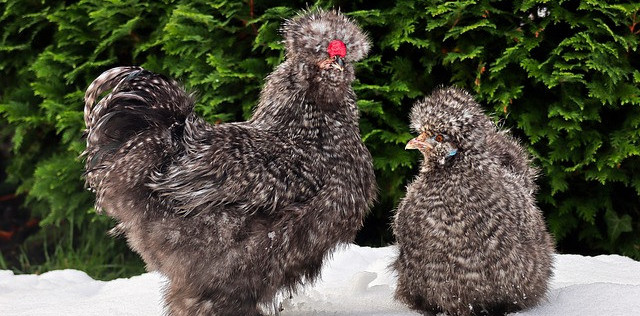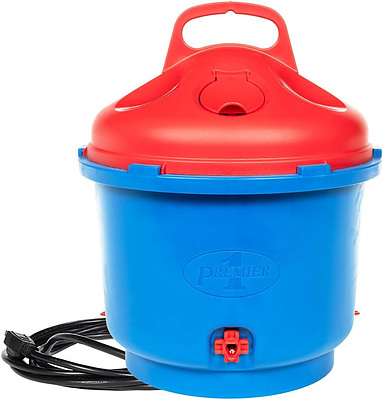We just went through another lovely winter here in Upstate New York, and my chickens all survived. This isn’t Minnesota, but it gets pretty darned cold here, with temperatures dropping below zero Fahrenheit for days. So, I know a little about how much cold chickens tolerate in the winter, and it’s why I’m writing Keeping Chickens Warm Cold Weather.
Keeping Chickens Warm
The benefits of keeping chickens warm are kind of obvious, but it doesn’t hurt to list them.
First of all, a warm chicken is a happy chicken, and a happy chicken is a chicken that will lay happy eggs! Ah, you say, but chickens don’t lay well in the winter.
They will if a heat lamp in the coop provides heat and light. My chickens laid consistently all winter this year. The light disrupted their sleep a little, but they still slept. The red light put out by the heat lamp is vital for stimulating sexual maturity and egg production in chickens.
There is some concern over keeping chickens up all night with artificial light, but I can assure you that my chickens slept with the light on for the most part. I digress…
Keeping chickens warm is important to keep their body parts from getting frostbite. Combs and wattles are sensitive organs and help regulate a chicken’s body temperature. Unfortunately, they are the most exposed parts of a chicken’s body. The cold can easily affect these organs in temperatures below freezing.
To keep egg counts consistent, you must keep a hen’s stress level to a minimum. Keeping her warm is a great way to do that in the winter. Plenty of food and water is important to keep up your birds’ strength to fight the cold. This brings us to the next topic.
Cold Weather Chicken Waterer
You can find heated waterers that cost anywhere from $30.00 to $90.00. The lower-priced ones are open like a dog dish. I do not recommend those unless you can fashion a cover over them. Chickens are awesome creatures, but they do lack social graces when it comes to when and where they defecate. Some others look like a typical waterer, except they have a heated bottom.
You can make your own heated waterer by taking a cinder block or any other inflammable object with a similar shape… a metal cylinder of some sort, or heavy masonry pot, whatever you can find that won’t tip over easily, and put a light bulb in the hollow center. Place your summer waterer on top, and voila – heated waterer. Two things to be careful of… don’t let the bulb rest on the wooden floor or touch the plastic waterer. Common sense, really.
How Much Cold Can Chickens Tolerate?
Quite a bit if your coop is built right. I’m talking about a coop that will house up to 20 chickens.
A coop should be insulated, surely, but that is not enough. Chickens eat Styrofoam and fiberglass insulation. I don’t mean they gobble it up like it’s chicken feed, but out of boredom, they will peck at and eat insulation, so you have to cover it with plywood or similar material.
A coop should be windproof while also being ventilated. A small, tight coop will keep in body heat but also keep in ammonia gas from chicken droppings. This is unhealthy, so ventilation and a heat source other than the chicken’s body heat should be considered.
I have good luck with a basic heat lamp. The heat supplements the chickens’ heat, and the red light helps stimulate egg production – a win-win.
Chicks are much more sensitive to the cold than adult chickens because they don’t yet have adult feathers. They are really vulnerable in the first few days after hatching.
Baby chicks should be kept at a temperature of 90-95 degrees Fahrenheit when they hatch, and then reduce the temperature over a five-week period until you get to about 70-75 degrees. This procedure will have to be performed in a brooder. The brooder is outside this post’s scope but can be investigated at BABY CHICK BROODERS, another post of mine.
The most important thing to remember when it comes to heating your coop is that you don’t want to burn it down. Oil-filled space heaters are a viable option. The spring cleaning involved using these can be a little unsavory, if you know what I mean.
Cold Weather Bedding
Unless you have radiant heat in your coop, you must keep a thick layer of bedding on the coop floor. Cold from the ground beneath the coop can wick up into the floor and freeze the bottom layer of bedding if it is moist, which it will probably be. More than 4 inches of shavings or straw will do the trick.
I like coarse pine shavings that I buy at two places in my local area. The bags are easy to handle, the shavings are large enough that they won’t be mistaken for food, they are absorbent, and they smell pretty good.
Chicken Feed
During times of high stress, such as when a chicken is injured, during molting, or during a hard winter, keeping a bag of high-protein chicken feed around is advisable.
This is only a supplement and must not be used as a main food source. High-protein chicken feed should be administered like you would scratch grains – occasionally, and only a handful or two at a serving. Read the instructions on the bag for proper administration of the feed.
If you don’t want to buy high-protein feed, you can hard boil some eggs, cut them up in little chicken bite-sized pieces, and give them to your chickens as a protein supplement. Boiled eggs don’t smell like or have the same texture as raw eggs, so you won’t have to worry about encouraging your chickens to cannibalize the raw eggs in the coop.
Keeping chickens warm in the winter isn’t hard unless you don’t prepare for the cold ahead of time. When autumn comes rolling in, start getting ready by ensuring you have a tight coop with ventilation but no draft, plenty of bedding, and a reliable heater for the coop and the water. Buy a bag of high-protein chicken feed, and you should be all set.
It is a good idea to start out on your chicken-raising adventure with chickens that are naturally cold-hardy.
I appreciate you reading this. If you’d like to discuss this, ask a question, or just say hello, feel free to leave a message below, and I’ll get right back to you.
See ya ’round,
Dave
Chickenmethod.com



Hey Dave, thank you for such a fabulous read on Keeping Chickens Warm In Cold Weather! I love my eggs in the morning so I know exactly why it’s so important to keep those chickens warm. You have provided much useful help with this article, not just to keep the chickens happy but keeping the eggs flowing should make their keepers happy as well.
I can understand if the light kept the chickens from getting the rest they need as I have had the same experience myself when trying to sleep during the day.
Do you really think it is okay to feed the chickens their own cooked eggs? Just seems a little questionable to me but I am a novice.
Hello Joseph. Thanks for the kind words.
Yeah, it’s okay to feed them cooked eggs in moderation because the cooked eggs are changed in both form/texture and aroma compared to a raw egg. Just a note on soft foods – chickens LOVE foods like cooked eggs and peas, but too much soft food can, and eventually will, lead to clogging the crop. Sometimes the chicken can be saved by massaging the crop, or turning the chicken upside down and making it vomit, but sometimes the chicken doesn’t make it.
Great question! I hope I answered it for you. ’til next time…
Dave